Imagine it’s a fall day and you live in Michigan (or Ohio or Wisconsin or any of the other northern states where raking leaves is an annual pain). You know another freezing winter is just around the corner; one cold enough that you dream about escaping to sunny Florida to bask in the warmth of the south, play a game or two of shuffleboard, go fishing on the flats, take an afternoon nap beneath the palms, and end your day toasting the sunset with a colorful cocktail.
Except that it’s the early 1900s and the only way to get to Florida is via passenger train and the only people who can afford to board a passenger train are the wealthy, which you are not. True, there are automobiles, like the Ford Model T, but it’s the early 1900s and the United States lacks a road system to get you from up north to down south. So you’ll spend another year suffering the brutal cold of winter.
That’s just the way life is. Or is it?
Along comes 1915 and the creation of the Dixie Highway, a national road system (some dirt, some gravel, some newly paved) that connects towns and cities all the way from Michigan to Florida. The race is on for families to escape the cold by heading south. Actually, it wasn’t a race, because it took an average of 17 days (about 100 miles per day) to make the trip. You and others loaded up Model T Fords with tents, cooking gear, food, clothing, and everything else needed to spend the winter months in Florida.
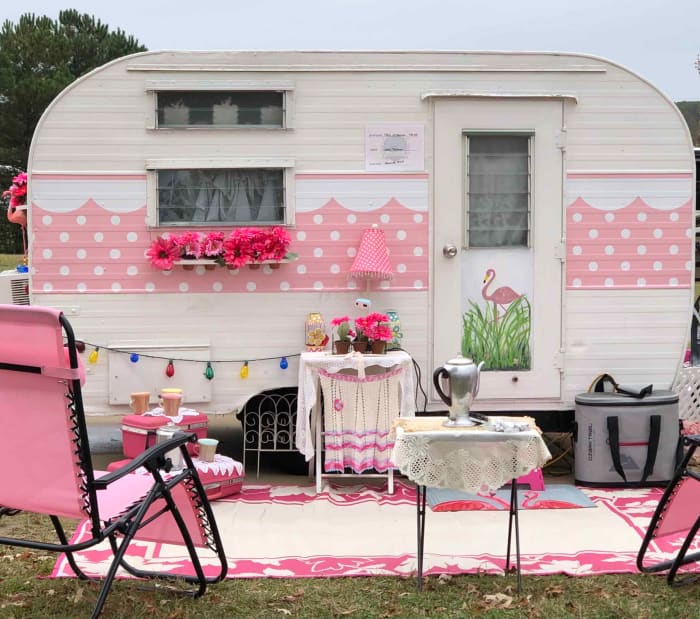
This pretty in pink 1960 Li’l Beaver Camper is owned by Leslie Thompson of Newman, Georgia.
Image courtesy of Rick Cook
There were no campgrounds, so tents were set up in city parks in Arcadia, Sarasota, St. Petersburg, Tampa, and surrounding towns. As more northerners arrived by car for the winter, city officials began to think of them as gypsies, which they were not.
Tin Can Tourists Origin
In 1919, about two dozen campers met at Desoto Park in Tampa to organize the Tin Can Tourists (TCT), an automobile camping club that promoted safe and clean campgrounds, high moral standards, and family entertainment. Officers were elected, bylaws were written, new members were sought, and land was acquired to create permanent winter camps in Florida. By 1938, the Tin Can Tourists club had grown to more than 100,000 people.
Somewhere along the way, travel trailers were invented. Instead of living in tents, TCT members had all the comforts of home. Annual conventions were held every winter in Florida and every summer in Michigan. These conventions were big deals, where most of the major trailer manufacturers displayed their latest products. TCT club meetings were held, seminars were presented, games were played, potluck dinners were shared.
Annual growth continued … until it didn’t. Membership took a massive hit during the 1960s and 1970s, when cheap airline flights, chain motels, Disney World, Universal Studios, family-oriented cruise ships, and all-inclusive destinations (like Club Med) drove a spike through the heart of the Tin Can Tourists. By the end of the 1980s, the club died.

A 1969 Shasta trailer owned by Rick and Bonnie Cook of Pembroke Pines, Florida, is staged with a 1960 Chevrolet Nomad Station Wagon owned by Daryl and Suzie Odom, Parish, Alabama. Rick and Bonnie collect Coke and Pepsi memorabilia.
Image courtesy of Rick Cook
Then came the resurrection. Forrest and Jeri Bone had owned several Airstream trailers over the years and were longtime members of the Vintage Airstream Club (VAC). They owned a 1964 Airstream in 1998, when Forrest was the president of that club. Over time, Forrest felt “uncomfortable in an organization that took pride in excluding others.” In other words, people who didn’t own Airstreams weren’t welcome.
After talking with friends within the niche hobby of vintage trailers, Forrest decided to research historical records to find legal documents relating to the once-mighty Tin Can Tourists club.
“TCT had been registered in Florida,” Forrest says, “but not renewed after 1986. We did a trademark search and registered in Michigan in 1998.” Word was put out that TCT was holding a renewal gathering in Michigan in May of that year, opening up for all, with no limitations on membership. No one would be excluded; not even people with new trailers; not even people without trailers.
RELATED CONTENT: When a Pepsi-drinking husband and a Coke-loving wife buy a vintage trailer they name Bubbles, you know they are in for some carbonated fun.
Twenty-one vintage trailers attended that first event in Michigan. Forrest was appointed to the wonderfully named position of Royal Tin Can Opener (Director) and Jeri became the First Lady of the resurrected Tin Can Tourists club. The purpose of the club was to celebrate friendships (old and new) and honor the past by bringing vintage trailers back to life and sharing them. In 2000, the newly envisioned club held its first gathering in Florida with a national trademark.
The Bones held their leadership positions until 2020, one year after celebrating TCT’s Centennial (1919-2019). During their 21 years of service, the couple organized and coordinated more than 500 TCT events around the country, serving as rally hosts for more than 100 events in Michigan and Florida, according to the TCT website (TinCanTourists.com).
The responsibility was immense. The Bones planned and hosted more than 100 events similar in size to an average wedding in terms of participants, entertainment, meals, and logistics. On top of that, most TCT events last four days (usually Thursday through Sunday), not just one day.
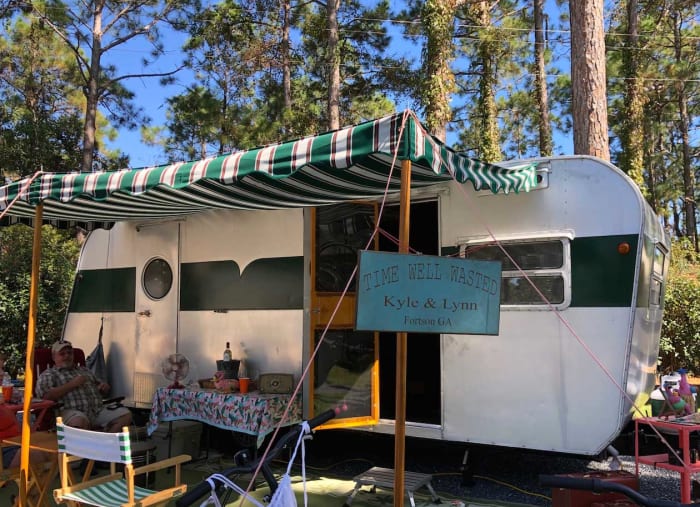
1954 West-Wood trailer owned by Kyle and Lynn Kinman of Forston, Georgia. The sign on the canopy post says it all: “Time Well Wasted.”
Image courtesy of Rick Cook
While running TCT, they brought the club from nonexistent to approximately 2,000 memberships. And even that’s understating their accomplishments with the club. A single membership can be one person camping alone or a family of five camping together in one trailer, so there’s no way of knowing the exact number of individual members in the club.
What’s more, during Forrest’s tenure as the Royal Tin Can Opener, the TCT website became an archive of historical data about the Tin Can Tourists, as well as a research site with information about hundreds of brands of vintage trailers.
When Forrest and Jeri stepped down, the torch was passed to their son, Terry, and his wife, Michelle, who became the new Royal Tin Can Opener and First Lady of the Tin Can Tourists club. Under their guidance, the Tin Can Tourists has grown to more than 2,500 memberships.
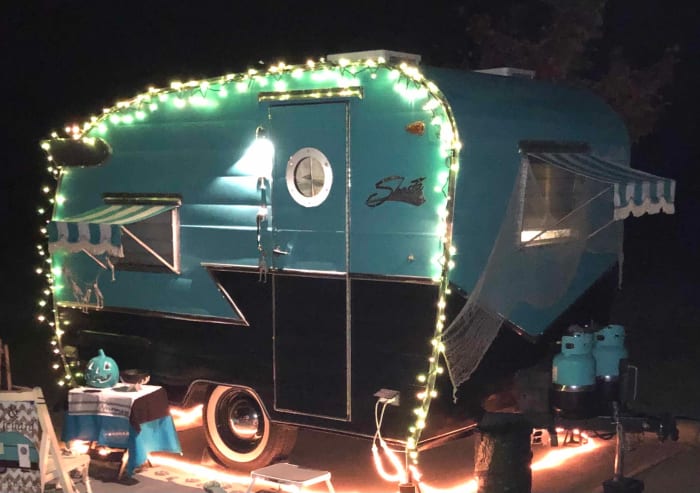
This 1963 Shasta camper owned by Cindy Freebourgh, Little Rock, is decorated for Halloween.
Image courtesy of Rick Cook
TCT: A Growing Interest
While other clubs across the country struggle to add new members, the TCT has blossomed. But why?
“The TCT can be a great resource for answering questions about buying their trailer, learning about their trailer, finding restoration advice and parts for their trailer, and finding events to attend,” Terry Bone says. But there’s more. “Nearly every active member in the club who attends rallies will tell you that they’ve made friendships that will last a lifetime. Just like the trailers at our rallies are so diverse, so are the owners. I’ve never met a friendlier group.”
Harvey Dunn owns a 1979 Argosy and a 1970 Williams Craft with his wife, Astrid. “I never had a hobby before getting involved with vintage trailers at the age of 70,” says Harvey, who had a career in business before becoming a pastor. “TCT brought a totally new dimension to my life. The friendliest people around are TCT vintage trailer people!”
Harvey is now 80 and still going strong, towing one of his two trailers to rallies across the southeastern United States. Not only are the trailers vintage, so is the couple’s home in Floral City, Florida; one of the oldest homes in that town’s historic district. Dating back to 1907, this two-story masterpiece was the boyhood home of well-known Florida historian Hampton Dunn, Harvey’s uncle. Filled with hundreds of antiques, the Dunns give house tours as part of an annual Citrus County Historical Society celebration.
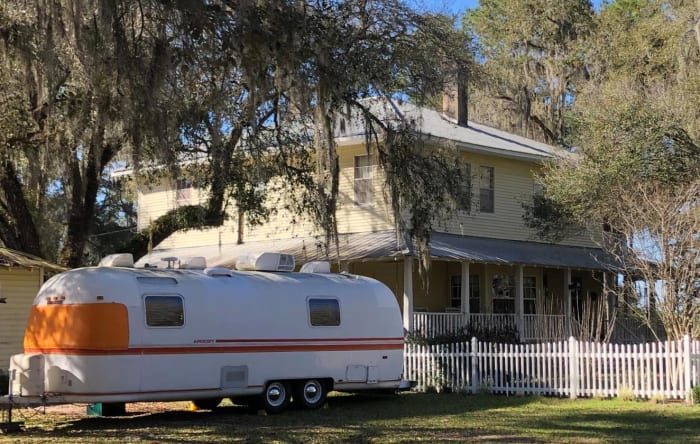
The 1979 Argosy owned by Harvey and Astrid Dunn parked beside their historic home in Floral City, Florida.
Image courtesy of Rick Cook
“Vintage trailers give us a common place to start our relationship,” Terry Bone says. “But spending weekends sharing food, laughing, singing, and hanging out around a campfire making memories is what cements the friendships that carry on well beyond the club. People attend an event or two to see the trailers, but after that they are coming back to hang out with their best friends.”
What exactly is a TCT event? Well, it’s lots of things, from a one-day street fair (such as the Floral City Strawberry Festival, where vintage trailers line up along closed streets) to a four-day rally at a campground (such as the Winter Convention in Brooksville, Florida).
A four-day rally usually begins with everyone setting up their trailers on the first day, followed by a meet-and-greet cocktail hour. The next two days are filled with activities (catered meals, potlucks, games, live music, singing, dancing, tours of historical sites, swimming, hiking, biking, classic car shows, or just hanging out with friends around a campfire). The final day involves packing up and saying goodbye to friends until the next event.
At some rallies, an open house is held, allowing members to tour each other’s trailers. When a public open house is held (typically on a Saturday afternoon), the public is invited to tour all the vintage trailers, most of which have been decked out by their owners with interior and exterior displays, whether they be period-correct antiques, holiday themes (such as Halloween or Christmas), or some other type of theme (such as Flamingos, Tiki, Country & Western, Beach Shack, General Store, Gypsy, or Cola Wars).
“Rallies are lots of fun and the trailers are always a joy to see and check out,” says TCT member Bev Reger, who owns a 1957 Airstream and a 1970 Shasta (as well as a modern teardrop trailer) with her husband, Roger. “Lots of great ideas are found with fellow TCT folks.”

A 1957 Airstream owned by Roger and Bev Reger of Lakeland, Florida, is staged with the Regers’ 1955 Chevrolet 150 Business Coupe. Many vintage trailer owners are also into vintage automobiles.
TCT members Denis and Ginger Blaquiere “enjoy gathering with old and new friends, whether at an official rally or an informal campout. It’s just plain fun!”
Denis is the Florida State Representative for TCT, so he’s involved with organizing and hosting rallies throughout the southernmost state. To make sure rallies are held across the country and not just in Michigan and Florida, TCT has appointed several State Representatives from sea to shining sea.
Vintage Trailer Charm
Why someone would want to own a vintage trailer rather than a new one may not be obvious to the uninitiated. But for the Blaquieres the reason is clear-cut. “Vintage trailers are so darn cool and are of superior construction compared to anything new,” they say. “Our 1975 Avion is over 45 years old and still rock solid.”
The Regers agree, stating that vintage trailers, “have so much more character as opposed to the new box trailers. More thought and design went into the vintage ones. There is also a warmth to an older trailer when you enter the door.”
“Once restored,” says TCT member Alice Ramos, who owns a 1983 Avion with her husband, Ronald, “vintage trailers take on a personality of their own, and no two are alike. They do not have to be perfect; their ‘beauty marks’ give them character.
“Vintage trailers do not have all the modern amenities of newer trailers, although with some ingenuity, upgrades can be added to suit your needs,” says Alice, who restored her trailer by herself, having grownup with a father who taught her how to use tools at a young age.
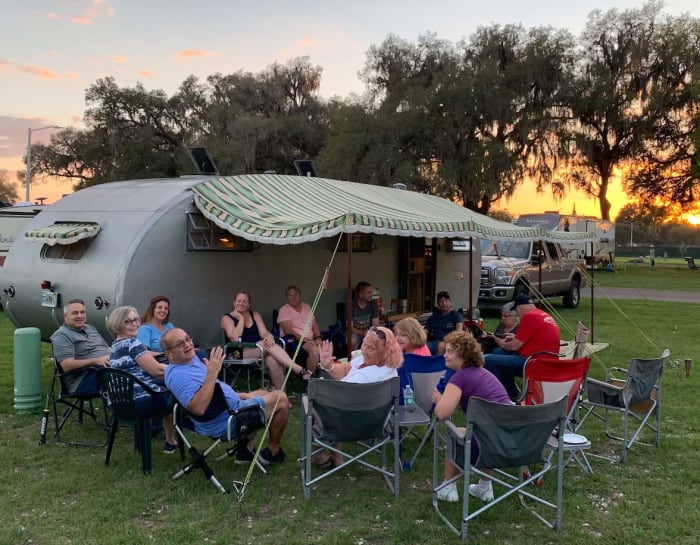
Tin Can Tourists club members doing what they do best – enjoying each other’s company.
Image courtesy of Rick Cook
“I enjoy the camaraderie and mutual love for all things vintage,” Alice Ramos says. “I love how everyone is welcome, regardless of the age or condition of their trailer. Whenever we gather, it’s like camping with 100 of your closest friends. Departure time is always sad, as we all look forward to our next gathering.”
“No matter what type of camping you do,” Bev Reger says, “whether in a tent, van, fifth wheel, trailer, or motor home, everyone is welcome. Although most TCT members have vintage trailers, no one is left out.”
Finding a Vintage Trailer
When considering a vintage trailer, there are a litany of questions that come to mind. Where do you look? What should you look for? Are there any pitfalls? To answer these questions, I went to Tim Heintz, owner of Heintz Designs Vintage Trailer Restorations in Panama City, Florida, one of the largest and oldest vintage trailer restoration shops in the country specializing in trailers of all makes and models from the 1920s to 1970s.
Vintage trailer restorations started out as a hobby for Heintz while he was still a teenager. He went off to college, earned a degree in architecture, and started a career as a high-end residential architect. Then the economy tanked. Having maintained his vintage trailer hobby throughout the years, Heintz started a side business restoring vintage trailers for other people. Over a short period of time, he found himself doing less architectural work and more vintage trailer work. It wasn’t long before he was completely out of the architectural business and running Heintz Designs full time.
“Vintage trailers are truly everywhere,” Heintz says. “Online vintage trailer websites are a great place to find vintage trailers in various styles and conditions. Most people actually find their trailer ‘out in the wild’ and simply ask the owner about ‘the old trailer’ in the backyard or field and inquire if it’s for sale; oftentimes it is!
“But be warned; although vintage trailers are a lot of fun, they are also a lot of work,” Heintz says. “Even if a vintage trailer appears to have just a small amount of damage (rot, water stains), they almost always hide far more damage that will require a total rebuild. It is not difficult work, but it takes a ton of patience to restore a trailer correctly before you get to the fun part of decorating and usage.”
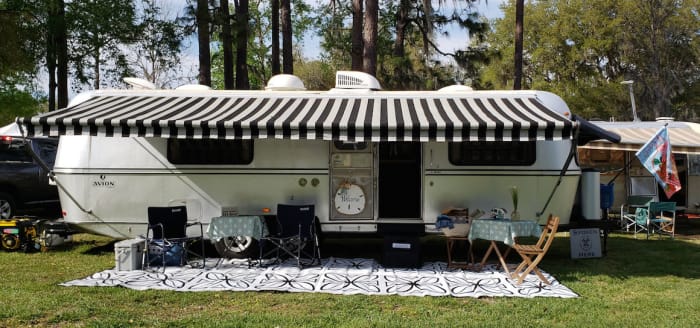
This 1983 Avion trailer is owned by Alice and Ronald Ramos of Lakeland, Florida. Alice completely restored the trailer, which has a beach-cottage-theme interior.
Image courtesy Rick Cook
“Right now vintage trailers are as hot or hotter than the housing market,” Terry Bone says. “Trailers that are priced appropriately receive many offers and sell very quickly, so you need to put in the time (research) and act quickly if you are serious about wanting to buy a vintage trailer.
“The best places to leverage your time are vintage trailer classified websites (such as TinCanTourists.com), eBay, Craigslist, Facebook MarketPlace, and restoration company websites, which often have project trailers that people can purchase and personalize during the restoration,” Bone says.
Another good place to search is at a vintage trailer rally on the day the rally holds a public open house. Look for the For Sale signs on trailers. The author of this article found his 1969 Shasta at a rally in Pine Mountain, Georgia, while covering that rally as a freelance writer for Vintage Camper Trailers magazine.
What about average TCT members? What advice can they give to someone new to the hobby?
“Do your homework first,” Denis Blaquiere advises. “Decide what size and type of rig will suit your needs. Do not make a purchase based on an emotional response. Too often a purchase will be made on impulse without really ‘seeing’ what was purchased, only to discover the cute rig they’ve acquired is a disaster under a pretty façade.”
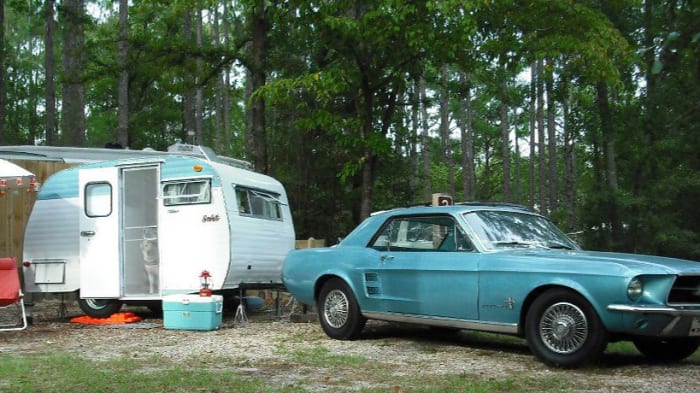
1968 Serro Scotty Sportsman with a 1967 Mustang restored by Heintz Designs..
Image courtesy Heintz Designs
“There are many issues that need to be of concern, such as water stains on the ceiling, walls, and around vents,” Roger Reger says. “If the flooring is soft, the trailer could need a completely new floor. These are just a few possible issues. Even if you get the trailer for free (the previous owner just wanted to get that ‘hunk of junk’ out of the yard), the cost of the trailer can quickly escalate. Take someone with you who is knowledgeable about older trailers.”
That’s another advantage of joining TCT. By becoming a member before you buy a vintage trailer, you’ll be able to attend rallies, where you’ll meet “members who have wisdom in trailer repair and restorations,” Heintz says, adding that TCT members are “always willing to help out new members.”
Another reason to join TCT early, Bone adds, is the club’s website, which has “resources to help inspect a trailer and resources on how to go about a restoration.” It also has links to dozens (if not hundreds) of related websites, including vintage trailer parts suppliers and vintage trailer restoration companies.
“The vintage trailer buyer needs to understand his or her ability and willingness to restore a trailer.” Heintz says. “Vintage trailers listed in classifieds range from those that were professionally restored and cost well over $20,000, to trailers that are in severely damaged condition and will require a complete frame-off restoration to make them usable again. You have to understand what you are willing to take on either with your own time and skills or with your pocketbook.”
By pocketbook, he means hiring a professional vintage trailer restoration shop to bring your trailer back to life. Advice from someone who completed her own restoration comes from Alice Ramos, who said you must “be prepared for cuts, scrapes, and bruises while restoring your trailer. It always looks worse when the layers are peeled, but with elbow grease and creativity the outcome will be well worth it.”
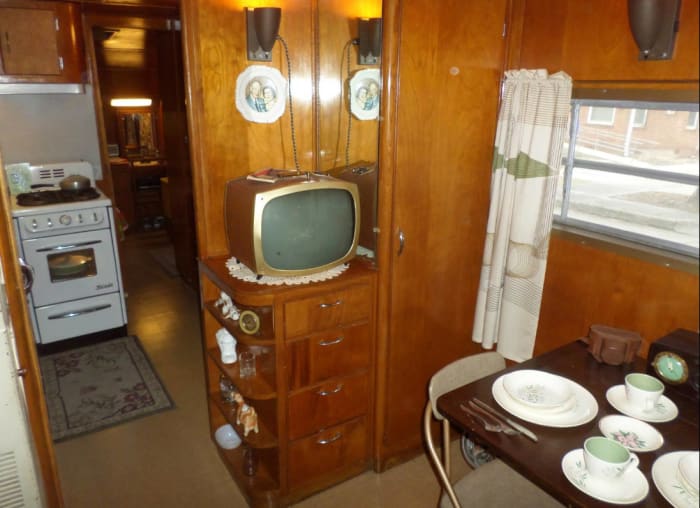
Restored by Tim Heintz, the inside of a 1950 Spartanette Tandem 30-footer is a wonderful time capsule featuring authentic pieces and incredible detail
Image courtesy Heintz Designs
“The last major consideration,” according to Bone, “is paperwork (title, registration, and bill of sale). Many vintage trailers are sold without proper paperwork and this can be a nightmare for the new owner. Different states have different rules and processes, so make sure you know what challenges you’re accepting when buying a trailer without a title.”
And don’t forget insurance, Forrest Bone says.
“The need to purchase adequate insurance as quickly as possible should be mentioned” Forrest Bone says. “A vintage trailer can be a valuable asset at the time of purchase.”
Good advice, Forrest, and thank you for resurrecting the Tin Can Tourists back in 1998!
The cost of a TCT annual membership is $20 for the entire family when purchased through TCT’s website and jumps to $25 if you mail a check via the U.S. Postal Service. For more information, visit TinCanTourists.com.









